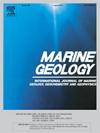Sedimentary dynamic processes affected by tropical cyclones and anthropogenic forcing in a small-scale estuary: The Sheyang River Estuary, China
IF 2.2
3区 地球科学
Q2 GEOSCIENCES, MULTIDISCIPLINARY
引用次数: 0
Abstract
Amid the robust landward migration of tropical cyclones (TCs) in the context of global warming, the sedimentary dynamic processes in coastal areas are increasingly affected by TCs. Concurrently, coastal environments face tremendous stress from anthropogenic interventions, such as land reclamation and jetty construction. However, most research puts more emphasis on TC impacts on large-scale estuaries or marginal seas, leaving the sediment dynamics in small estuaries, particularly under the influence of TCs and man-made structures, largely unexplored due to the limited field data. To address this issue, this study took the Sheyang River Estuary (SRE) as an example and explored the sediment dynamic responses to TCs and the jetty construction during Typhoon Lekima in August 2019, utilizing the Finite Volume Coastal Ocean Model (FVCOM). The results showed that the rotating wind field of Lekima induced rapid variations in wave height, residual water level, and currents at different typhoon stages and strengthened the sediment resuspension and alongshore transport. Furthermore, by comparing the effects of Lekima with Typhoon Chan-hom in July 2015, we found that TCs with different tracks produced markedly different dynamic processes, yet all facilitated sediment exchange between the northern and southern areas within the SRE. The study also highlighted the impact of jetty construction on sediment transport during typhoons, noting that jetties can disrupt the typhoon-induced alongshore sediment flux and create eddies on either side by altering sediment advection. In the navigational channel area, the construction of jetties can strengthen the along-channel estuarine circulation during typhoon events, potentially leading to severe channel siltation by trapping riverine sediments and inducing net landward sediment transport. While site-specific, this study provides valuable insights into the combined effects of extreme events and human interventions on sedimentary environments in small estuaries.
热带气旋和人为强迫对射阳河河口小尺度沉积动力过程的影响
在全球变暖背景下,热带气旋向陆地强烈迁移的背景下,沿海地区的沉积动力过程日益受到热带气旋的影响。与此同时,沿海环境面临着人为干预的巨大压力,如填海造地和码头建设。然而,大多数研究更多地侧重于TC对大尺度河口或边缘海的影响,而由于野外数据有限,对小河口的沉积物动力学,特别是在TC和人造结构的影响下,在很大程度上没有进行探索。为解决这一问题,本研究以射阳河河口(SRE)为例,利用有限体积海岸海洋模型(FVCOM),探讨了2019年8月台风“利基玛”期间,沉积物对tc和防波堤建设的动力响应。结果表明:利基马的旋转风场引起了台风不同阶段浪高、剩余水位和海流的快速变化,加强了沉积物的再悬浮和沿岸运输;此外,通过比较2015年7月台风“利基马”和“灿鸿”的影响,我们发现不同路径的台风产生的动力过程明显不同,但都促进了SRE内南北地区的泥沙交换。该研究还强调了防波堤建设对台风期间沉积物运输的影响,指出防波堤可以破坏台风引起的沿岸沉积物通量,并通过改变沉积物平流在两侧形成漩涡。在航道区,防波堤的建设可以在台风期间加强沿航道的河口环流,通过截留河流沉积物和诱导净向陆地输沙,可能导致严重的航道淤积。虽然具体地点不同,但这项研究为极端事件和人类干预对小河口沉积环境的综合影响提供了有价值的见解。
本文章由计算机程序翻译,如有差异,请以英文原文为准。
求助全文
约1分钟内获得全文
求助全文
来源期刊

Marine Geology
地学-地球科学综合
CiteScore
6.10
自引率
6.90%
发文量
175
审稿时长
21.9 weeks
期刊介绍:
Marine Geology is the premier international journal on marine geological processes in the broadest sense. We seek papers that are comprehensive, interdisciplinary and synthetic that will be lasting contributions to the field. Although most papers are based on regional studies, they must demonstrate new findings of international significance. We accept papers on subjects as diverse as seafloor hydrothermal systems, beach dynamics, early diagenesis, microbiological studies in sediments, palaeoclimate studies and geophysical studies of the seabed. We encourage papers that address emerging new fields, for example the influence of anthropogenic processes on coastal/marine geology and coastal/marine geoarchaeology. We insist that the papers are concerned with the marine realm and that they deal with geology: with rocks, sediments, and physical and chemical processes affecting them. Papers should address scientific hypotheses: highly descriptive data compilations or papers that deal only with marine management and risk assessment should be submitted to other journals. Papers on laboratory or modelling studies must demonstrate direct relevance to marine processes or deposits. The primary criteria for acceptance of papers is that the science is of high quality, novel, significant, and of broad international interest.
 求助内容:
求助内容: 应助结果提醒方式:
应助结果提醒方式:


